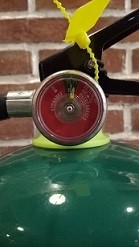While it is important to know how to identify a proper-functioning fire extinguisher, it is equally important to be aware of the common issues that arise and how to respond.
Fire Extinguisher Location Obstructed
Issue: When a fire extinguisher is obstructed, it could mean the difference between life and death. Pay attention to instances where a portable fire extinguisher may be behind furniture, office equipment, and doors, or hidden under office desks and sink cabinets.
Action: You should immediately remove obstructions, or reposition the fire extinguisher. Make sure it is easily seen by everyone. Place it along a natural path of travel, such as a hallway or an entrance/exit. Post it under a clear fire extinguisher signage.
Cylinder Has Dents and/or Rust
Issue: As fire extinguishers often remain unused, they can experience physical deterioration due to a humid or corrosive environment, constant transfers, or accidental bumps. Physical defects can lead to malfunction or dangerous explosions.
Action: Immediately forward the cylinder to the manufacturer for replacement.
Fire Extinguisher Overcharged or Undercharged
Issue: An extinguisher with a good charge will have sufficient velocity to spur the chemical. 3 – 6m. An overcharged fire extinguisher can cause leakage or worse, a cylinder explosion. An undercharged one can be equally dangerous and be unable to extinguish the fire.
Action: Immediately forward the cylinder to the manufacturer for replacement /recharge.
Locking Pin Missing/Broken Seal
Issue: Locking pins and seals can go missing when they have not been replaced after training exercises, have been tampered with, or were simply not installed in the first place. These two must always go together as they prevent accidental pressing of the lever and release of the fire extinguisher’s contents.
Action: Whichever is missing, immediately get replacements from your supplies. Pins and seals are either made of metal or plastic. If not in stock, contact your fire extinguisher provider or go to your nearest hardware store.
Fire Extinguisher Not Elevated from the Floor
Issue: A fire extinguisher directly on the floor may cause others to accidentally bump it off, which can further cause dents to the body. The changing temperature of the floor can also directly affect the fire extinguisher, which can cause a change in pressure.
Action: Depending on the cylinder size, the standard practice is to mount it via metal brackets on a wall, 1m – 1.5m above the floor. Alternatively, you could also use wooden or steel fire extinguisher stands.
Check the Pressure Gauge
Examine where the gauge needle is. A needle within the green zone is good. A needle in the left red zone means that the fire extinguisher is undercharged and warrants a recharge, while a needle in the right red zone signals the danger of being overcharged.

Click on the link/s below to open the resources.